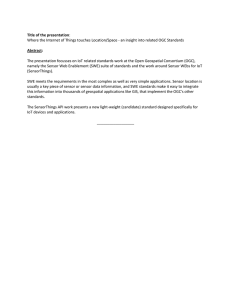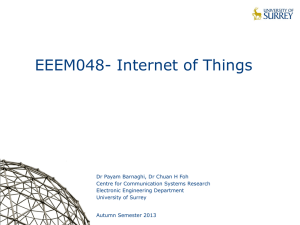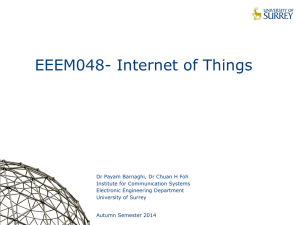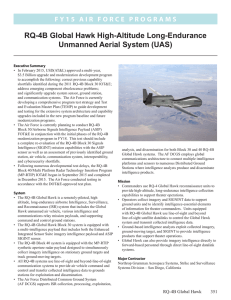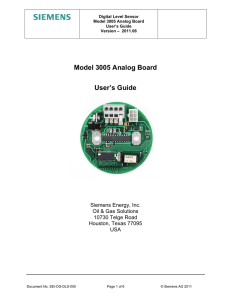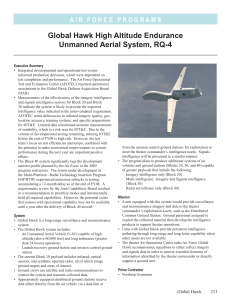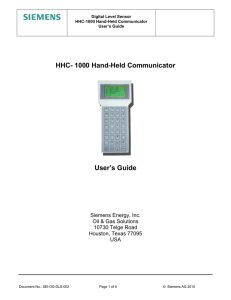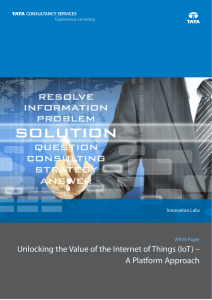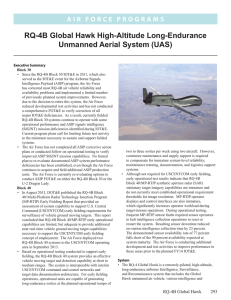Internet of Things
advertisement
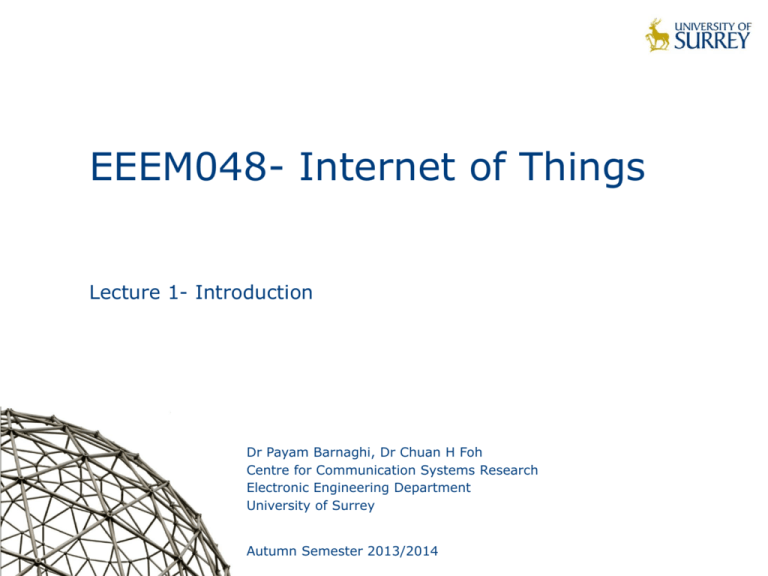
EEEM048- Internet of Things Lecture 1- Introduction Dr Payam Barnaghi, Dr Chuan H Foh Centre for Communication Systems Research Electronic Engineering Department University of Surrey Autumn Semester 2013/2014 1 Module Aims − The main aim of this module is to introduce the fundamental concepts of the Internet of Things and its applications and architecture models; − Introduction to the technologies and mechanisms for sensing, actuation, processing and cyber-physical data communication. − Discussing semantic technologies, service oriented solutions and networking technologies that enable the integration of Internet of Things data and services into the cyber world (i.e. the Internet and the Web). − To develop practical skills that can be transferred into a real-world environment. 2 3 Sensor devices are becoming widely available - Programmable devices - Off-the-shelf gadgets/tools 4 More “Things” are being connected Home/daily-life devices Business and Public infrastructure Health-care … 5 People Connecting to Things ECG sensor Internet Motion sensor Motion sensor Motion sensor 6 Things Connecting to Things - Complex and heterogeneous resources and networks 7 Wireless Sensor Networks (WSN) End-user Core network e.g. Internet Gateway Sink node Gateway Computer services - The networks typically run Low Power Devices - Consist of one or more sensors, could be different type of sensors (or actuators) 8 How are the networks changing? − Extensions − More nodes, more connections, IPv6, 6LowPan,... − Any TIME, Any PLACE + Any THING − M2M, IoT − Billions of interconnected devices, − Everybody connected. − Expansions − Broadband − Enhancements − Smart networks − Data-centric and content-oriented networking − Context-aware (autonomous) systems 9 Future Networks 10 10 10 “Thing” connected to the internet Image Courtesy: : CISCO 11 11 Internet of Things (IoT) − Extending the current Internet and providing connection, communication, and inter-networking between devices and physical objects, or "Things," is a growing trend that is often referred to as the Internet of Things. − “The technologies and solutions that enable integration of real world data and services into the current information networking technologies are often described under the umbrella term of the Internet of Things (IoT)” 12 Why should I learn about IoT? − Business trend − Emerging technologies − Growing IoT Services and Application 13 Opportunities 14 Source: http://blog.trentonsystems.com/internet-of-things-crosses-business-personal-boundaries/ Technology trend 15 Market growth − “According to a study conducted by Frost & Sullivan in 2011, the global RFID market of $3 billion to $4 billion (in 2009) will grow by twelve percent per year through 2016 and reach a volume of approximately $6.5 billion to almost $9 billion.” − 80 percent of all households in the European Union are expected to have intelligent power meters by 2020. − A building’s energy management can then be monitored and administered remotely via a smartphone or a PC. Market experts predict that this global market, which represented $5.3 billion in 2010. − In February 2012 the Chinese government therefore decided to set up a fund of approximately $775 million to support this field in the next five years. It will grow to $11 billion by 2015. − This sector is expected to grow to $116 billion by 2015, according to a report published by the Xinhua News Agency in late 2010. Source: Siemens, http://www.siemens.com/innovation/apps/pof_microsite/_pof-fall-2012/_html_en/facts-and-forecasts-growth-market-of-the-future.html 16 Smart product sales Source: Siemens, http://www.siemens.com/innovation/apps/pof_microsite/_pof-fall-2012/_html_en/facts-and-forecasts-growth-market-of-the-future.html 17 Internet Connected devices Source: Siemens, http://www.siemens.com/innovation/apps/pof_microsite/_pof-fall-2012/_html_en/facts-and-forecasts-growth-market-of-the-future.html 18 Global Data Generation - Everyday around 20 quintillion (10^18) bytes of data are produced (Source: http://www01.ibm.com/software/data/bigdata/). - This data includes textual content (unstructured, semi-structured, structured) to multimedia content (images, video and audio), on a variety of platforms (enterprise, social media, and sensors). 19 Data Generation 20 Internet of Things Module Image courtesy: Wilgengebroed 21 Topics − Cyber-Physical systems, smart devices, sensors and actuators − Key applications, protocols and architectures − Networks and Communications (Wireless Multi-hop Networks (WMN), Mobile Ad-hoc Networks (MANET), Wireless Sensor Networks (WSN)) − Reliability, Security, Privacy and Trust issues and solutions − − − − Software platforms and services Intelligent Data Processing and Semantic technologies Connecting things to the Web Applications, system models, Standards, and PhysicalCyber-Social systems 22 Module Teaching − Dr Chuan H Foh: Hardware Platforms, Networking and Security − Dr Payam Barnaghi: Services, Data Processing and Applications − 3 hours (Lecture + Lab) − Lecture room: − Lab: Penguin Lab (3rd Floor, BB Building) − Thursday, 10am to 13:00pm 23 Assessment − Written Exam (60%) − Coursework (40%) − Coursework − Lab exercise − Lab exercises will be done during the lab hours − Written report − Will include an essay (details will be provided)- the essay will be maximum 3 pages (including references). 24 Pre-requisites − We expect you are familiar with hardware systems. − We expect you know about basic communication and networking. − We expect you have a knowledge of the object oriented programming. 25 Module Web Link − All the slides and additional material will be uploaded to SurreyLearn − http://surrylearn.surrey.ac.uk 26 Some of the related material − Reading List: − http://aspire.surrey.ac.uk/lists/35640FC8-892D-E309E66C-F07C3D9BCB28.html − ETSI, Machine to Machine Communications − http://www.etsi.org/technologies-clusters/technologies/m2m − Machine-to-Machine Communications, OECD Library, − http://www.oecd-ilibrary.org/science-and-technology/machine-to-machinecommunications_5k9gsh2gp043-en − W3C Semantic Sensor Networks − http://www.w3.org/2005/Incubator/ssn/XGR-ssn-20110628/ 27 Topics To be Covered − Please see the slides sets for Part II of the introduction lecture. 28 Questions? 29
